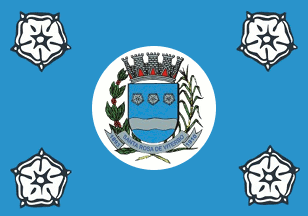 image by
Dirk Schönberger,
30 January 2013
image by
Dirk Schönberger,
30 January 2013Based on: http://www.santarosa.sp.gov.br/omunicipio/dadosmunicipio.html

Last modified: 2013-02-02 by ian macdonald
Keywords: sao paulo | santa rosa de viterbo |
Links: FOTW homepage |
search |
disclaimer and copyright |
write us |
mirrors
 image by
Dirk Schönberger,
30 January 2013
image by
Dirk Schönberger,
30 January 2013
Based on:
http://www.santarosa.sp.gov.br/omunicipio/dadosmunicipio.html
A blue flag with the municipal arms on a white disk in the centre and a black-lined white rose in each corner.
Official website at
http://www.santarosa.sp.gov.br
Dirk Schönberger,
30 January 2013
Santa Rosa de Viterbo emerged around a chapel built near São Simão following the arrival of the Mogi Railways in 1883. Henrique Dumont purchased land to establish the Amália Estate. The municipality of Ibiquara was established in 1910, seceding from São Simão. The municipality was subsequently renamed Santa Rosa, Icaturama, and, eventually, Santa Rosa de Viterbo.
The municipality is named for St. Rose of Viterbo (1235-1252,
canonized in 1457 by Pope Callistus III). Enrolled in the Third Order
of St. Francis, Rosa was sent in 1247 to preach penance to Viterbo, at
that time held by Frederick II of Germany. Expelled from Viterbo in
January 1250, she foretold on 5 December 1250 the death of the
emperor, which happened on 13 December. She returned to Viterbo in
1251 following the restoration of the papal power.
http://www.newadvent.org/cathen/13193a.htm - Catholic Encyclopaedia
The symbol of Santa Rosa de Viterbo are prescribed in Article 3 of the
Municipal Constitution, adopted on 5 April 1990, as "the flag, the
coat of arms and the anthem of Santa Rosa de Viterbo".
http://www.santarosa.sp.gov.br/decreto_lei/lei_org.pdf - Municipal
Constitution
The flag is blue with a white rose in each corner and the municipal coat of arms in the middle, placed on a white disk.
Photo of the flag
http://guinnessbrasil.blogspot.fr/2007/06/recordista-carlos-henrique-arrecada.html
http://www.santarosa.sp.gov.br/noticias/2012/cdhu/cdhu.html
The coat of arms is prescribed by Law No. 270 of 14 December 1956. The coat of arms is a modification of Salvador Thaumaturgo's draft, made to match Lauro Ribeiro Escobar's style of coat of arms. The coat of arms is "Rounded-off shield, azure a fess wavy argent in chief three roses of the same. The shield surmounted by a eight- towered mural crown argent ports gules. The shield surrounded dexter by a branch of coffee fructed and sinister by a sugarcane the two proper. Beneath the shield a scroll argent inscribed with the municipality's name surrounded by the years '1893' and '1910' all azure."
The rounded-off, or Iberic shield, used in Portugal at the time of
discovery of Brazil, is a tribute to the first colonizers and builders
of our country.
Azure (blue) is a symbol of justice, beauty, sweetness, nobleness,
perseverance, incorruptible firmness, glory, virtue, zeal and loyalty.
The fess wavy represents the water resources of the municipality,
especially river Pardo that irrigates the lands of Santa Rosa de
Viterbo.
The roses evoke St. Rose of Viterbo, the municipality's patron saint
and namesake. Beside making the arms canting, the rose is a symbol of
grace, beauty, honour, suavity, youth, nobleness and merit.
Argent is a symbol of felicity, temperance, purity, truth, frankness,
integrity and friendship.
The mural crown is a symbol of municipal emancipation. The open ports
are a symbol of hospitality. Gules is the colour of Law and Justice,
meaning that Santa Rosa de Viterbo is the seat of a "comarca" and
recalling the dictum "Justice is Found Through These Ports".
The branch of coffee and the sugarcane show the fertility of the
generous soil of the municipality, being important crops there.
The years "1893" and "1910" recall the establishment of the district
and of the municipality, respectively.
http://www.camarasrviterbo.sp.gov.br/index2.php? - Website of the Municipal Council
Ivan Sache, 31 January 2013